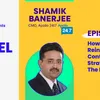How Scripbox shapes its content marketing strategy in the fintech space
In this episode of Pepper Content’s Top of the Funnel series, Manu Prasad, Chief Marketing Officer, Scripbox, talks about the challenges and opportunities of content marketing in the fintech space.
Scripbox is India’s leading digital wealth management service and is recognised for creating simple and elegant user experiences in a complex domain.
Scripbox uses proprietary algorithms to deliver a holistic view of investments and personalised recommendations for better outcomes.
Manu Prasad has been leading this company’s marketing team for a while now and has experience working for brands like Myntra, Urban Ladder, and others.
Talking about the role of content evolving over the years, he says in the early 2000s, the content was actually the product. Blogs, newsletters, audio content — everything was a novelty. Today, everybody is doing everything content-wise.
“I have seen content play many roles from demand generation to lead conversion, to engagement. Today, the content can be made in seconds by anybody who has a smartphone and internet. Therefore, everyone is doing storytelling and running advertising campaigns. Now, both the creation and consumption of content are easy; there is also freedom of choice. For example, you can watch a recipe and yoga video and a TV show simultaneously,” says Manu.
Scripbox’s content game
Talking about Scripbox, Manu says the content here has reformed him.
“Most people want ease with their finances. The entire discussion is around a transaction now. It is now a relationship. We want to create content that sparks curiosity and not doubts or fears. We don’t take a negative approach and scare customers into an investment,” he says.
Investments are not impulse-purchase products, and thus, educational content is necessary to facilitate the decision-making process. Scripbox’s blog has over 1000 articles and similar hub content on YouTube, mostly about overcoming industry bias. The idea is to convince the customer by showing utility.
In this domain, the real work starts after you have got a customer, explains Manu as he talks about ensuring that a customer stays. For this, Scripbox has a blog called ‘News That Matter’, which gives the customer contextually relevant content.
How content fits into the overall marketing machinery
What works at Scripbox is to look at content from the customer journey point of view, that is, what content works at what time and in what format, whether it is visual, audio, written, etc.
“Rather than hiring an army of writers for SEO, we work with freelancers and concentrate on creating content that is useful for the customer,” says Manu, explaining his team’s structure.
“The old way of churning out ecommerce or SEO content is gone. Google, too, believes in ranking content that is useful,” he adds.
Content at Scripbox is also created with the channel-first approach since Manu believes that channel defines usage, and usage defines the kind of content you should produce.
Challenges in the fintech space content
According to Manu, the biggest challenges of content marketing today are:
1. Mental availability of the customer: Since customers have an infinite amount of content to choose from, the main job is to cut through the clutter and make content stand out.
This is more challenging in the fintech space. Investing is also tricky to sell, and they have a lot of options in that domain too. Decreasing attention span is also a challenge.
2. Decreasing shelf life of the platforms themselves: Initially, an organic audience was built. Now everything can be paid, and so the utility decreases in itself. In the last couple of years, TikTok emerged, and now it has vanished. The complexity of it all affects the content strategy. Today, if you’re in marketing, you must read the platforms carefully to strategise better, and that’s a major challenge.
Manu says while there are challenges, there are also several opportunities in the form of storytelling.
“The content, format, and options are getting better. This type of availability is great and also increases engagement and connectivity and mixes the community with the brand,” he explains.
On the technology side, things have changed with the onset of gaming, artificial intelligence, etc. “Social media will soon become legacy media, and people will move to more happening options like Discord, Clubhouse, etc. The technology explosion opens up many opportunities for content creators and marketers,” he adds.

Measuring success when it comes to content
Manu reminisces about his favourite campaign he did in the finance space. “It’s called FUQ or Frequently Unasked Questions. It involves a playlist on YouTube on the unasked questions regarding investments. It is about asking the right questions. The whole intention of Scripbox is to help people make better decisions when it comes to their wealth management. The right questions will not only ensure the safety of your investment but also help you achieve your financial goals,” says Manu.
Fintech content for a younger audience and during the pandemic
People are more conscious and mature now and want to start investing early. Their investments, too, are larger.
“At Scripbox, our target audience is in the mid-30s because that is when you realise that life is not just going to go on. The younger generation is impulsive and long-term vision might be missing. In-mid 30s, things fall into perspective,” explains Manu, talking about creating content for a younger audience.
Future of digital marketing in fintech
Today, a lot of people spend on digital. There is a lot of headroom to grow even volume-wise digital marketing, feels Manu as he explains that in the fintech space, a high level of digital transformation has happened in personal finance in the last year. Right from using Google Pay for transactions to the options available for transacting online.
Customers, therefore, are at different stages of maturity. To begin with, they want a frictionless transaction like can you buy financial products the way you buy something online.
As maturity increases, you want some help in decision-making to understand if this product is right for you, and therefore, communication needs to be personalised.
Next comes replicating the relationship that people have had before with their bank’s relationship manager. We need to think about what it takes to have that relationship online.
Money is a taboo subject, and there is an opportunity to democratise it and content can do it. Like we did with mental health, financial health is a good content entry point. Thus, content marketing has a very bright future.
Among formats, we first had social networks, and now we have artificial intelligence-powered interest networks, where there is a lot of interactive content.
If you look at podcasts and Discord, they’re enforcing their strategy. Now, we are creating content on social media that will get us validation and applause. First, we make the tool; then, the tool shapes us.
YourStory’s flagship startup-tech and leadership conference will return virtually for its 13th edition on October 25-30, 2021. Sign up for updates on TechSparks or to express your interest in partnerships and speaker opportunities here.
For more on TechSparks 2021, click here.
Applications are now open for Tech30 2021, a list of 30 most promising tech startups from India. Apply or nominate an early-stage startup to become a Tech30 2021 startup here.
Edited by Suman Singh










